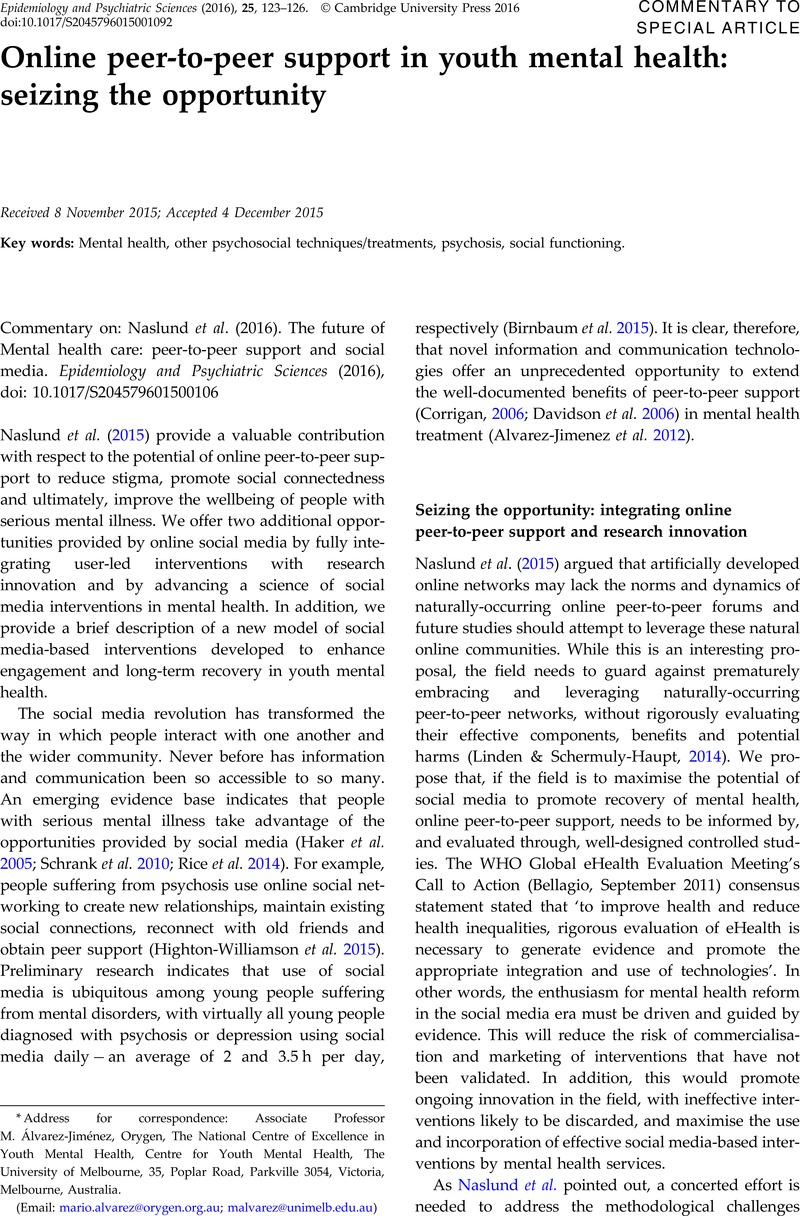Crossref Citations
This article has been cited by the following publications. This list is generated based on data provided by Crossref.
D'Alfonso, Simon
Santesteban-Echarri, Olga
Rice, Simon
Wadley, Greg
Lederman, Reeva
Miles, Christopher
Gleeson, John
and
Alvarez-Jimenez, Mario
2017.
Artificial Intelligence-Assisted Online Social Therapy for Youth Mental Health.
Frontiers in Psychology,
Vol. 8,
Issue. ,
Gleeson, John
Lederman, Reeva
Koval, Peter
Wadley, Greg
Bendall, Sarah
Cotton, Sue
Herrman, Helen
Crisp, Kingsley
and
Alvarez-Jimenez, Mario
2017.
Moderated Online Social Therapy: A Model for Reducing Stress in Carers of Young People Diagnosed with Mental Health Disorders.
Frontiers in Psychology,
Vol. 8,
Issue. ,
Ridout, Brad
and
Campbell, Andrew
2018.
The Use of Social Networking Sites in Mental Health Interventions for Young People: Systematic Review.
Journal of Medical Internet Research,
Vol. 20,
Issue. 12,
p.
e12244.
Alvarez-Jimenez, M.
Gleeson, J.F.
Bendall, S.
Penn, D.L.
Yung, A.R.
Ryan, R.M.
Eleftheriadis, D.
D'Alfonso, S.
Rice, S.
Miles, C.
Russon, P.
Lederman, R.
Chambers, R.
Gonzalez-Blanch, C.
Lim, M.H.
Killackey, E.
McGorry, P.D.
and
Nelson, B.
2018.
Enhancing social functioning in young people at Ultra High Risk (UHR) for psychosis: A pilot study of a novel strengths and mindfulness-based online social therapy.
Schizophrenia Research,
Vol. 202,
Issue. ,
p.
369.
Bailey, Eleanor
Rice, Simon
Robinson, Jo
Nedeljkovic, Maja
and
Alvarez-Jimenez, Mario
2018.
Theoretical and empirical foundations of a novel online social networking intervention for youth suicide prevention: A conceptual review.
Journal of Affective Disorders,
Vol. 238,
Issue. ,
p.
499.
Sharma, Bhuvan
Puri, Harshita
and
Rawat, Deepika
2018.
Digital Psychiatry - Curbing Depression using Therapy Chatbot and Depression Analysis.
p.
627.
Santesteban-Echarri, Olga
Álvarez-Jiménez, Mario
Gleeson, John
and
Rice, Simon M.
2018.
Technology and Adolescent Mental Health.
p.
187.
Alvarez-Jimenez, Mario
Bendall, Sarah
Koval, Peter
Rice, Simon
Cagliarini, Daniela
Valentine, Lee
D’Alfonso, Simon
Miles, Christopher
Russon, Penni
Penn, David L
Phillips, Jess
Lederman, Reeva
Wadley, Greg
Killackey, Eoin
Santesteban-Echarri, Olga
Mihalopoulos, Cathrine
Herrman, Helen
Gonzalez-Blanch, Cesar
Gilbertson, Tamsyn
Lal, Shalini
Chambers, Richard
Daglas-Georgiou, Rothanthi
Latorre, Cristina
Cotton, Sue M
McGorry, Patrick D
and
Gleeson, John F
2019.
HORYZONS trial: protocol for a randomised controlled trial of a moderated online social therapy to maintain treatment effects from first-episode psychosis services.
BMJ Open,
Vol. 9,
Issue. 2,
p.
e024104.
McEnery, Carla
Lim, Michelle H.
Knowles, Ann
Rice, Simon
Gleeson, John
Howell, Simmone
Russon, Penni
Miles, Chris
D’Alfonso, Simon
and
Alvarez-Jimenez, Mario
2019.
Development of a Moderated Online Intervention to Treat Social Anxiety in First-Episode Psychosis.
Frontiers in Psychiatry,
Vol. 10,
Issue. ,
Killackey, Eóin
and
Alvarez-Jimenez, Mario
2019.
Clinical Staging in Psychiatry.
p.
241.
Halsall, Tanya
Manion, Ian
Iyer, Srividya N.
Mathias, Steve
Purcell, Rosemary
and
Henderson, Joanna
2019.
Trends in mental health system transformation: Integrating youth services within the Canadian context.
Healthcare Management Forum,
Vol. 32,
Issue. 2,
p.
51.
Prescott, Julie
Rathbone, Amy Leigh
and
Brown, Gill
2020.
Online peer to peer support: Qualitative analysis of UK and US open mental health Facebook groups.
DIGITAL HEALTH,
Vol. 6,
Issue. ,
Gibson, Kerry
and
Trnka, Susanna
2020.
Young people's priorities for support on social media: “It takes trust to talk about these issues”.
Computers in Human Behavior,
Vol. 102,
Issue. ,
p.
238.
Rice, Simon
O'Bree, Bridget
Wilson, Michael
McEnery, Carla
Lim, Michelle H.
Hamilton, Matthew
Gleeson, John
Bendall, Sarah
D'Alfonso, Simon
Russon, Penni
Valentine, Lee
Cagliarini, Daniela
Howell, Simmone
Miles, Christopher
Pearson, Marc
Nicholls, Laura
Garland, Nicola
Mullen, Edward
McGorry, Patrick D.
and
Alvarez-Jimenez, Mario
2020.
Leveraging the social network for treatment of social anxiety: Pilot study of a youth-specific digital intervention with a focus on engagement of young men.
Internet Interventions,
Vol. 20,
Issue. ,
p.
100323.
McEnery, Carla
Lim, Michelle H.
Knowles, Ann
Rice, Simon
Gleeson, John
Howell, Simmone
Russon, Penni
Miles, Chris
D'Alfonso, Simon
and
Alvarez‐Jimenez, Mario
2021.
Social anxiety in young people with first‐episode psychosis: Pilot study of the EMBRACE moderated online social intervention.
Early Intervention in Psychiatry,
Vol. 15,
Issue. 1,
p.
76.
van Doorn, M.
Popma, A.
van Amelsvoort, T.
McEnery, C.
Gleeson, J. F.
Ory, F. G.
M. W. M., Jaspers
Alvarez-Jimenez, M.
and
Nieman, D. H.
2021.
ENgage YOung people earlY (ENYOY): a mixed-method study design for a digital transdiagnostic clinical – and peer- moderated treatment platform for youth with beginning mental health complaints in the Netherlands.
BMC Psychiatry,
Vol. 21,
Issue. 1,
Kang, Ezer
Mellins, Claude A.
Kim, Woojae
Dolezal, Curtis
Kindler, Christine
Leu, Cheng-Shiun
and
Abrams, Elaine J.
2021.
Navigating Stigma Trajectory and Mental Health Among Young Adults Living with Perinatal HIV in New York City.
AIDS and Behavior,
Vol. 25,
Issue. 11,
p.
3712.
Rice, Simon
O'Bree, Bridget
Wilson, Michael
McEnery, Carla
Lim, Michelle H.
Hamilton, Matthew
Gleeson, John
Bendall, Sarah
D'Alfonso, Simon
Russon, Penni
Valentine, Lee
Cagliarini, Daniela
Howell, Simmone
Miles, Christopher
Pearson, Marc
and
Álvarez‐Jiménez, Mario
2021.
Development of a graphic medicine-enabled social media-based intervention for youth social anxiety.
Clinical Psychologist,
Vol. 25,
Issue. 2,
p.
140.
Halsall, Tanya
Daley, Mardi
Hawke, Lisa
and
Henderson, Joanna
2021.
Exploring Peer Support Services for Youth Experiencing Multiple Health and Social Challenges in Canada: A Hybrid Realist-Participatory Evaluation Model.
International Journal of Qualitative Methods,
Vol. 20,
Issue. ,
Andalibi, Nazanin
and
Flood, Madison K
2021.
Considerations in Designing Digital Peer Support for Mental Health: Interview Study Among Users of a Digital Support System (Buddy Project).
JMIR Mental Health,
Vol. 8,
Issue. 1,
p.
e21819.



